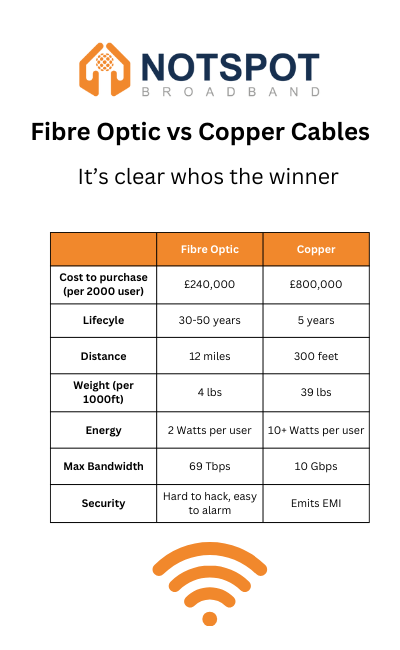If you live or have stayed in a rural area you’ll notice that Wifi is often not good or completely non existent. Compared to larger or more populated areas rural wifi is often very bad. Despite super fast broadband being available to 97% of UK homes and businesses. There’s still a large number of rural locations where this kind of wifi is simply not available. According to research done by Comparethemarket, fast broadband is not available to 14% of rural locations.
One factor that affects this is that less populated areas don’t get the same level of service due to their being less people so the need is a lot less. Internet service providers, often driven by economic considerations, find it economically challenging to justify the extension of their services to areas with a limited number of potential subscribers.

The lower population density in rural regions reduces the return on investment for deploying and maintaining Wi-Fi infrastructure. The traditional model of internet provision relies heavily on a large customer base to cover the costs associated with installation and ongoing maintenance. In rural areas, where homes are more spread out, the economics often don’t align with the traditional business model, leaving many communities on the outskirts of the digital revolution.
The heart of the matter lies in the scarcity of infrastructure, the expanse of terrain, and the high costs associated with bringing robust Wi-Fi to remote regions. Yet, amidst these challenges, this is where Notspot Broadband comes in, part of the Obedio network.. In this blog post, we will delve into the intricacies of why it’s so challenging to secure a stable internet connection in rural areas and how innovative solutions like Notspot Broadband are emerging as a ray of light, promising to bridge the digital gap in our often-overlooked communities.
Lack of Infrastructure | Rural Wifi
Traditional internet service providers, driven by economic considerations, often hesitate to extend their networks into sparsely populated regions. The cost of laying down cables, erecting cell towers, and maintaining the necessary equipment is staggering, and the return on investment remains a critical concern.
Rural landscapes, characterized by expansive fields and scattered homesteads, present a logistical nightmare for infrastructure deployment. The vast distances between homes create a need for extensive cabling, amplifiers, and repeaters to maintain signal strength – a costly affair that deters many providers from venturing into these areas. Consequently, the lack of a robust physical network becomes a significant roadblock, leaving rural residents grappling with the frustration of unreliable or non-existent Wi-Fi.
Distance and Terrain
Theres often vast distances between homes in rural areas, coupled with the diverse and sometimes rugged terrains, create a formidable barrier for seamless internet access. Unlike the compact urban environment where Wi-Fi signals can effortlessly navigate through buildings, rural expanses with hills, valleys, forests, and bodies of water present a complex obstacle course.
Wi-Fi signals degrade over distance, and when faced with terrains that impede their path, the challenge intensifies. Hills and dense vegetation can absorb, reflect, or scatter signals, leading to significant signal loss. This results in “dead zones” where Wi-Fi signals struggle to reach, leaving residents with unreliable or non-existent connectivity.
The geographical diversity of rural areas poses a considerable challenge for conventional Wi-Fi deployment. The signal strength required to traverse long distances and overcome natural barriers demands a more intricate and resilient network infrastructure.

The above table shows the difference between copper wires and fibre optics. Despite the clear differences and the advantages of optic cables, many rural areas still use copper wires.
High Costs of Installation
The costs associated with installing Wi-Fi infrastructure makes it challenging in rural areas. The economics of extending networks to sparsely populated regions pose a significant deterrent for traditional internet service providers. The sheer expanses of rural areas, combined with the need for specialized equipment and manpower, contribute to a financial equation that often doesn’t add up. You can read more about how the installation is done from this website.
Laying down cables, setting up cell towers, and maintaining the network infrastructure require substantial investments. The return on investment becomes a critical factor, especially when the number of potential subscribers in rural areas is considerably lower than in urban counterparts. As a result, many internet service providers opt for more densely populated regions, leaving rural communities to grapple with the digital void.
The costs of installation also extend to ongoing maintenance. Remote locations may necessitate regular upkeep, and repairs can be both time-consuming and costly. The financial burden associated with the installation and maintenance of Wi-Fi infrastructure becomes a significant roadblock in the journey towards comprehensive rural connectivity.
Limited Population Density
In rural areas the sparse population density becomes a pivotal challenge to get reliable Wi-Fi. Internet service providers, often driven by economic considerations, find it economically challenging to justify the extension of their services to areas with a limited number of potential subscribers. According to the government website 17% of the population in the UK live in rural areas, read more.
The lower population density in rural regions reduces the return on investment for deploying and maintaining Wi-Fi infrastructure. The traditional model of internet provision relies heavily on a large customer base to cover the costs associated with installation and ongoing maintenance. In rural areas, where homes are more spread out, the economics often don’t align with the traditional business model, leaving many communities on the outskirts of the digital revolution.

As a consequence, limited population density creates a digital divide, with rural areas experiencing a lack of access to the online resources and opportunities enjoyed by their urban counterparts.
Technological Obsolescence
The lack of incentives for companies to upgrade infrastructure in less populated regions can result in a technological lag, leaving rural communities with slower and less reliable internet connections compared to their urban counterparts.
Obsolete technologies not only limit the speed and efficiency of internet services but can also hinder the adoption of newer applications and online tools. As the rest of the world embraces advancements in connectivity, rural areas may find themselves on the sidelines, cut off from the full spectrum of opportunities offered by the digital age.
The challenge of technological obsolescence is further compounded by the fact that upgrading existing infrastructure can be a costly and time-consuming endeavor. The reluctance of service providers to invest in the latest technologies for rural areas creates a significant barrier to achieving parity in digital access.
Alternative Solutions to bad Rural wifi
In the quest for reliable Wi-Fi in rural areas, the limitations of traditional approaches have spurred the exploration of alternative solutions. Recognizing the unique challenges faced by remote communities, various innovative approaches have emerged to bridge the digital gap and provide robust connectivity.
a. Satellite Internet: Satellite internet has become a game-changer for rural connectivity. By beaming signals from orbiting satellites directly to receiving dishes on the ground, satellite internet circumvents the need for extensive terrestrial infrastructure. This technology has the potential to cover vast rural expanses, bringing high-speed internet to areas where traditional methods fall short. Notspot Broadband provides a Starlink service, read more here.
b. Community-Driven Initiatives: Empowering local communities to take charge of their connectivity has proven to be a successful strategy. Community-driven initiatives involve residents actively participating in the deployment and maintenance of Wi-Fi infrastructure. This not only addresses the issue of limited population density but also fosters a sense of ownership and community engagement.
c. Government Programs: Some governments have recognized the importance of rural connectivity and implemented programs to subsidize or incentivise the extension of reliable Wi-Fi to remote areas. These initiatives aim to level the playing field by providing financial support to internet service providers willing to invest in infrastructure in underserved regions. The government is handing out £210 million to help rural areas to fast internet, homes can get vouchers worth £4,500, to help homes and businesses. This is called Gigabit Broadband Voucher Scheme.

